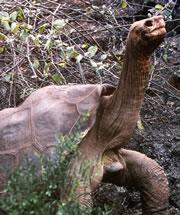 Lonesome George shows no interest in mating — but he has never met a female of his own kind.Thomas H. Fritts
Lonesome George shows no interest in mating — but he has never met a female of his own kind.Thomas H. FrittsLonesome George, conservation icon and apparent sole survivor of a species of giant Galápagos tortoise, may not be so lonely after all. Biologists have identified a living relative on Isabela Island, some 70 kilometres away from George's birthplace — an animal whose father (who may or may not be alive) is from the same population as George.
More than 450 years ago, the Galápagos Islands were crawling with over a dozen distinct populations of giant tortoise, each one isolated by water or active lava flows. But human exploitation and volcanic eruptions have since caused around a third of these populations to disappear, and Lonesome George, dubbed the "rarest living creature" by Guinness World Records, is thought to be the last remaining specimen of Geochelone abingdoni.
The new discovery hints that this may not be true: there may be other G. abingdoni alive in the Galápagos.
Sadly, the newly discovered tortoise — a sexually mature adult of at least 30 years old — is not a suitable romantic partner for George: he's male. And he's not purebred. While his father hailed from George's birthplace of Pinta island, his mother came from Wolf Volcano on Isabela.
But the discovery raises the possibility that there could be other, more suitable purebreds and hybrids living on Isabela — carriers of 'Pinta genes' and potential mates for Lonesome George. "The real holy grail is if we could find a pure Pinta female," says evolutionary biologist Jeffrey Powell from Yale University in New Haven, Connecticut, who participated in the study.
Friends reunited?
The team made its discovery after analysing DNA from seven Pinta tortoises, including Lonesome George and six deceased museum specimens, and comparing it against genetic material from 27 Isabela tortoises that had been previously collected. The result, reported in Current Biology1, showed up the one half-match to George.
So what are the chances that there might be a full Pinta tortoise out there?
Powell notes that there are about 8,000 tortoises living on Isabela, and their study looked at a random sample of only 27. "It's quite likely we'll find more," he says. This type of tortoise tends to lay clutches of around ten eggs at a time, says science writer Henry Nicholls, author of Lonesome George: The Life and Loves of a Conservation Icon. "So I wouldn't be surprised if he has siblings," he says.
But Linda Cayot, science advisor for the US-based Galápagos Conservancy, is more circumspect. Hatchling mortality is high and sex determination is likely to be temperature dependent, she says. So if there are any surviving siblings, they're also likely to be males.
And the chance that this rare male Pinta tortoise on Isabela met up with a female Pinta to breed with is probably slim.
It is unusual for these tortoises to travel great distances. It's possible that the mysterious Pinta father of this new tortoise fell into the water and drifted to Isabela, says Powell. The tortoises are not strong swimmers, but they can float with their head above water, and survive without food and drink for up to 6 months.
More plausible perhaps is the idea that whalers relocated the animal sometime around the sixteenth to eighteenth centuries. Historical records show that these hunters had a taste for giant tortoises, and that they unloaded some on Isabela en route to their whaling grounds. Stories also tell of pirates who dumped giant tortoises overboard to lighten their load while in chase. No one knows what the chance is of two Pintas ending up on Isabela this way.
It is unknown whether the full-Pinta father is still alive or not. The scientists have only a blood sample from the half-match to George, not the tortoise itself, so they don't know how old it is — it could be anywhere from 30 to 150 years old, says Cayot. If he's an old animal, his father is less likely to be around. "The discovery certainly raises more questions than it does answers," she says.
Looking for love
In the meantime, Lonesome George lives out his days at the Charles Darwin Research Station on the Galápagos island of Santa Cruz. He shares his enclosure with two Isabela females in the hope that one day he will muster up the lust for love. But so far, he has shown no interest in mating.
"He's a sad icon," says Powell. "Watching George is like watching a species go extinct. Our priority now is to go back and look for more." Funds willing, Powell and a team of around 20 scientists will return to Isabela next year and tag and collect DNA from up to 1,000 giant tortoises.
ADVERTISEMENT
And if they find purebred or hybrid Pinta animals? What happens next will be up to the Galápagos National Park, says Powell. If they find a female, one obvious option is to see whether she will fire up Lonesome George's loins, and help start a new colony for relocation on Pinta.
"But finding a Pinta population to found a Pinta population is decades away," says Cayot. "And Pinta needs tortoises now before its ecosystem is changed forever."
Visit our foundforlonesomege.html">newsblog to read and post comments about this story.
